#predator 75
Explore tagged Tumblr posts
Text
Sunseeker Predator 75
The next generation of Sunseeker Predator is quite a sight in the Shadow Grey Gelcoat and sleek Jet Black detailing to the exterior. The iconic coupé-style hardtop, coamings and air intakes are finished in LSA black paint, lowering the overall profile of an already aggressive silhouette. Dual colour blue and white Lumishore underwater lighting and 22 additional LED side deck lights transform the…

View On WordPress
#Boat News#British boat builders#poole#power yacht#predator#predator 75#Sports yacht#sunseeker#Sunseeker Predator#sunseeker predator 75#sunseeker yachts
1 note
·
View note
Text
ABCDEFGHI KLMNOPQRSTUVW YZ
24/26
*in the 2020s* he would do numbers on twitter *in the 2010s* he would get shares on his blog *in the 1990s* he would be a wiz on the multi-user dungeon *in the 1950s* he would get ratings on the television *in the 1930s* he would command the masses on the radio *in the 1880s* he would do dots and dashes on the telegram *in the 1790s* he would do arm signals on the semaphore *in the 1600s* his prints would be distributed widely *in the 1400s* he would sound the trumpet in battle *in the 700s* his words would be passed down by oral tradition *in the 300s* he would do smoke signals in the sky *in the neolithic* his artifacts would enter the archeological record *in the pliocene* his bones would be preserved in the sediment *in the mezozoic* he would do permineralization in mineral rich groundwater *in the paleoarchean* he would facilitate recombination of his genome *in the hadean* his molecules would self replicate in the early ocean *in the matter dominated era* his stellar nursery would collapse into a star and an orbiting cloud of dust *in the cosmological dark ages* quantum fluctuations in his density would form the first cosmological structures *10^-32 seconds after the big bang* his elementary particles would dominate in baryogenesis *in the plank epoch* he would do cosmic inflation in the energy dense early universe *10^-43 seconds after the big bang* he would be
#reblogs#>75%#>90%#would make a jab at he/him pronouns predating the universe but that's just the christian god
22K notes
·
View notes
Text

Let’s get to the point… it’s Fossil Friday! Styracosaurus was a large ceratopsian dinosaur that lived some 75 million years ago. It was related to Triceratops, but unlike its three-horned cousin, Styracosaurus had a singular nasal horn. It also possessed huge spikes on its frill—the bony collar that projects rearward from the skull. Scientists think that Styracosaurus may have used its headgear to defend against predators, to attract mates, to intimidate rivals, or to combat with others of its kind. You can spot this formidable dino in the Museum’s Hall of Ornithischian Dinosaurs!
Photo: © AMNH
#science#amnh#museum#fossil#nature#natural history#dinosaur#animals#paleontology#fact of the day#ceratopsian#styracosaurus#did you know#natural history museum
836 notes
·
View notes
Note
hello! i am a relatively new user here on tumblr, less than a year, and i have heard a comment or two about a 'wasp discourse' that happened here, that wasps are much more nice than bees or something among those lines
this caught my curiosity as im writting a wasp based character whos just an ahole as i did it on what i knew abt them from general internet and im stuck on wether i should maaayybe change them up a bit
if its not too much to ask do you happen to know a bit abt this discourse? or have a link to it? or if not to the discourse itself some other link that elaborates abt the same topic? perhaps even someone else i can ask this?
thank you very much!
to start off, there are a lot of bees and wasps in this world and it is not easy to generalize about them. there are ~20,000 bee species, and the vast majority of these are solitary bees that nest in the ground, plant stems, or in holes in wood, and because they produce no honey or have a colony to guard, have no need to be defensive or aggressive towards humans (because “towards humans” seems to be what most people base this idea off of). colonial bees, like honeybees, are actually much more defensive than solitary ones; they have huge food stores and many defenseless larvae, hence their nasty stings (or bites, for the stingless bees) and swarm defense of their hives.
bees, however, are just a family of wasps. their closest relatives are believed to be the crabronid wasps (example: cicada killers) and sphecid thread-waisted wasps (ex. mud daubers). these wasps, and most others, are also largely solitary, and hunting prey aside, don’t typically use their stings for anything other than personal defense. of the hundreds of thousands of wasps, most of them (75%) are not just solitary but also parasitoids that develop inside other insects. it’s hard to say “all wasps are assholes [to people]” when some 100,000 of them are tiny specks smaller than sesame seeds that nobody other than scientists notice.
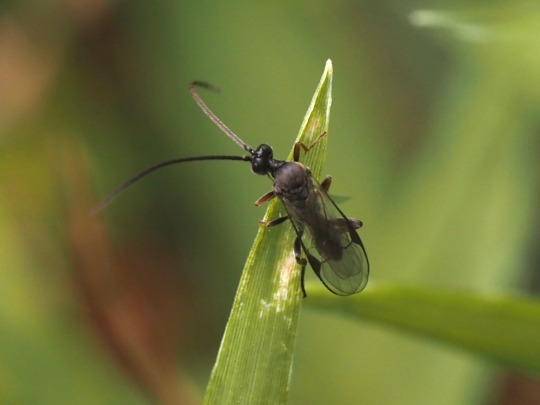
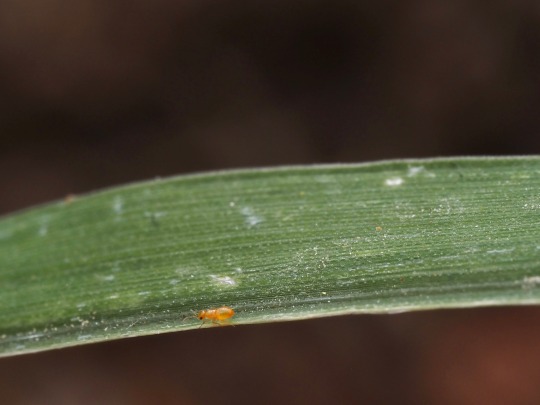
two parasitoids: a braconid ~3mm long & something else ~0.3mm long
the wasps most people take issue with are vespids, since they like the same foods we do (sweets, meat) and have powerful stings to defend their nests. these include the social hornets, yellowjackets, and paper wasps, but many mason wasps and the like are solitary (and, you guessed it, want nothing to do with people). vespids are great predators of caterpillars, flies, and other pests that humans don’t like in addition to being pollinators.
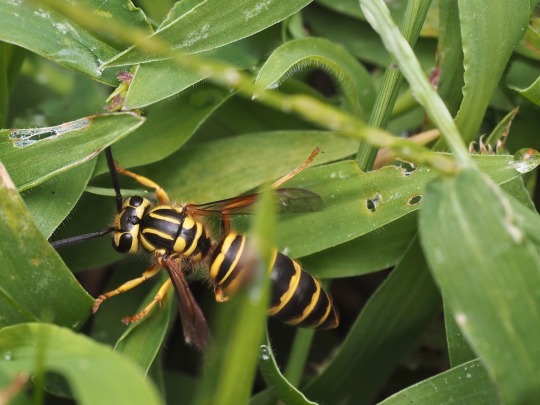
a yellowjacket: Vespula squamosa
the usual anti-wasp, pro-bee sentiments go: wasps attack for no reason, don’t pollinate, don’t make honey, and are “assholes.” wasps do pollinate (most wasps, bees and ants don’t eat solid food, and therefore largely drink flower nectar; some plants are only pollinated by wasps).
some tropical wasps do actually make honey, though it’s not harvested by humans. it’s sort of silly to say that making honey is what makes bees “good” though—a very selfish mindset, and for example butterflies are well-liked by people despite not making any edible products for us.
wasps also attack only when provoked, either because you’re near a wasp nest or when you lean on one accidentally. they are defending their baby sisters and themselves, same as bees would. at least in the US, I think the reason that wasps are so hated is that we have many species of paper wasp and yellowjacket that are willing to nest on or under houses, while the (invasive) honeybees prefer trees or are kept by beekeepers in artificial hives, so it’s just more likely you’ll run into problems with wasps than bees.
tl;dr:
wasps and bees are neither “nice” nor “mean.”
bees are mostly loners that don’t bother people. colonial bees will sting to defend their nests or themselves from predators. most bees are pollinators, who gather pollen to feed their larvae. a few species make honey that humans harvest.
wasps are mostly loners that don’t bother people. colonial wasps will sting to defend their nests or themselves from predators. most wasps are pollinators, and most hunt or parasitize other insects to feed their larvae.
1K notes
·
View notes
Text

While I delight in Timbern's beautiful Christmas fanarts, I've been cooking up this little attempt at an AU for several weeks now.
So I just imagined Tim trying to get to Bernard to get him safe from the vampire uprising that's been brewing in the shadows, reaching out to him as a civilian and planning to confess to him that he's Robin before taking him to the Bunker under Wayne Tower to keep him safe until they can find the vampire king and get rid of him.
Only the vampire king had gotten to Bernard long before him. Dick just wants his brothers by his side helping him rule the new world he's about to create. Turning Timmy's boyfriend and using him to set him up? That's just sweetening the deal for his brother, after all he wouldn't want to separate him from the person he loves, right?
If I ever stop criticizing DC vs Vampires?, is it because I have been cloned and my clone is managing the blog after getting rid of me 😆 Ok, so I just can't help but think of an AU where Dick hasn't lost 75% of his intelligence by becoming a villain and his desire to have his brothers by his side during the world government was legitimate. (and I will never forgive him for crushing Tim's head like a watermelon without even trying to recruit him to his side).
Also, have you seen that strange and somewhat erotic loyalty of vampires towards their king? That shit never failed to catch my attention.
As if, upon conversion, there was something that was disconnected in people's brains, if humanity had a switch and it simply turned off. They reason, they talk, they think and everything, but there is something so different about them. And that's fascinating.
It reminded me a little of the demons from Sousou no Frieren, who are capable of talking, thinking, planning and a lot of things, but they are not able to understand humanity. A predator that cannot understand its prey.
I think that would be really fun to work with in an AU, but unfortunately I'm too lazy for that lol.
#my art#lorena-art#red robin#tim drake#dc#timber#bernard dowd#reblog my own art#robin tim drake#timbern#vampire dick grayson#dick grayson#dc vs vampires#vampire bernard dowd
457 notes
·
View notes
Text
Wet Beast Wednesday: parrotfish
Which fish hangs out on a mermaid pirate's shoulder and repeats what she says in a high-pitched voice? The parrotfish, of course. Or at least in fiction they should (certainly will in my D&D world). But even in real life, parrotfish are still pretty interesting.
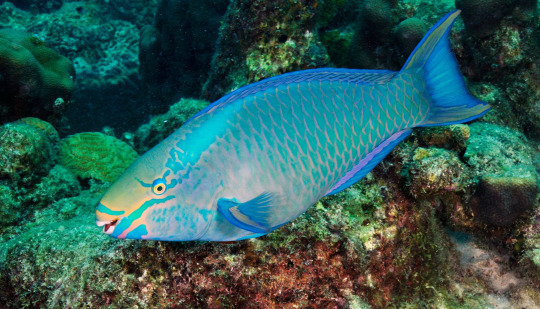
(Image: a common parrotfish (Scarus psittacus) seen from the side in front of rocks and corals. It is a brightly-colored fish, mainly light blue but with patches and stripes of yellow and pink on the fins. Its mouth is open, revealing what appears to be a beak. End ID)
Parrotfish are fish famous for their mouths and eating habits. There are about 90 species known. While they were historically considered their own taxonomic family, they have since been reclassified a subset of the wrasse family and there is still some debate on how to classify them. Most species are on the smaller size, but a few can get very large. The largest species is the green humphead parrotfish (Bolbometopon muricatum) at 1.5 meters (4.9 ft) and 75 kg (165 lbs) while the smallest species is the bluelip parrotfish (Cryptotomus roseus) reaching 13 cm (5 in). I could not find an average weight for the bluelips. What makes parrotfish really stand out visually is their colors and their mouths. Most species are very brightly colored, with distinct markings and males are usually more brightly colored than females. Their mouths are dominated by what appear to be beaks, which gave them their common name. These beaks are actually made of approximately 1,000 teeth arranged in 15 rows. As the teeth wear out, they drop off and are replaced by the row behind them. The teeth are made of fluorapatite, the second hardest biomineral int the world. To support their hardness, the fluorapatite crystals that make up the teeth are woven together in a structure very similar to chainmail, resulting in very hard teeth that measure in at a 5 on the Mohs scale of hardness. For reference, iron is a 4 and higher numbers are harder. The teeth can also handle 530 tons of pressure. You could put the weight of 200 black rhinos on a tooth and it would be fine. The beaks are powerful enough to bite through rock. Which is what they use it for, but more on that below. Another unusual feature of parrotfish is how they sleep. Some species make their own sleeping bags, which would be adorable if they weren't made of mucus. The mucus is produced using glands in the gills and looks like a transparent bubble. The fish sleeps in the mucus cocoon and when it wakes up, it eats the cocoon. There have been several proposed benefits of the cocoon. It contains chemicals that harm skin parasites while also providing a barrier that keeps new parasites from reaching the fish. It also likely blocks the fish's scent, helping it hide from predators.
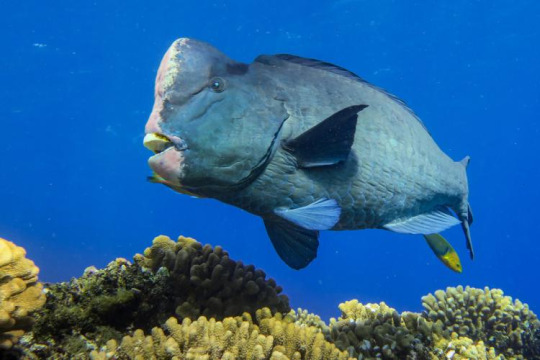
(Image: a green humphead parrotfish (Bolbometopon muricatum) swimming over yellow coral. It is large and mostly a uniform green color, except for the front of its head, which is pink. It has a large, fleshy lump on the top of its head. End ID)
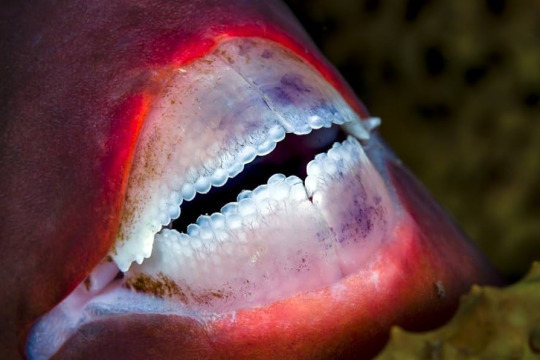
(Image: a close-up of a parrotfish's beak. The top and bottom beaks are divided into two halves, left and right. The beak is bade of small, circular teeth that overlap each other. End ID)
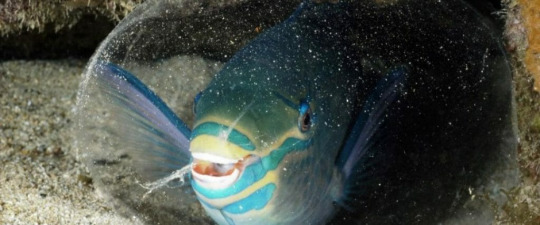
(Image: another common parrotfish seen from the front. It is inside of a mucus cocoon, which appears as a transparent bubble around the fish. Bits of sand dot the cocoon's surface. End ID)
Parrotfish live worldwide, though the majority of species are found in the Indo-Pacific. They live in warm, shallow waters with lots of rocky reefs, especially coral reefs. They use those powerful teeth to eat and what they eat most is algae. There are three main types of feeding behavior: excavating, scraping, and browsing. Excavators bite into rocks to get their food, scrapers crape food off of the surface of the rocks, and browsers go after larger food sources like seagrass and sponges. Some of the larger parrotfish species also make coral a large part of their diet. When they eat, they naturally get rock in their mouths, moreso in excavators. Because their food clings to the rock, spitting the rocks out would deny them food. Instead, parrotfish use pharyngeal teeth set in their throats to grind the rock into sand, which then passes through the digestive tract. When it exists the digestive tract, it is in the form of fine grains of rock. Or to put it another way, parrotfish eat rock and poop sand. A single parrotfish can produce up to 40 kg (88lbs) of sand yearly, and bigger species can produce even more than that. The process of rock being broken down by living things is called bioerosion and parrotfish are one of the most famous sources of bioerosion. The sand they produce can serve as the basis for new growth of coral or other species and helps reinforce nearby islands. In places like Hawai'i, the Caribbean, and the Maldives, it's estimated that up to 80% of the famous white sand is produced by parrotfish and they serve as a major source of incoming earth to support the islands. This makes parrotfish ecosystem engineers. Their eating of algae is also majorly important to their ecosystems. Algae can overgrow and smother delicate ecosystems like coral reefs and seagrass beds and decaying algae draws oxygen out of the water. Parrotfish help the health of their environments by keeping the algae population at healthy levels. Parrotfish also eat seaweeds and sponges that grow much faster than coral and can smother coral reefs. Parrotfish are considered keystone species in many reefs, including the great barrier reef and their population dropping correlates with reduced health of reefs. Damaged reefs tent to have larger parrotfish populations and those populations drop as the reef recovers.
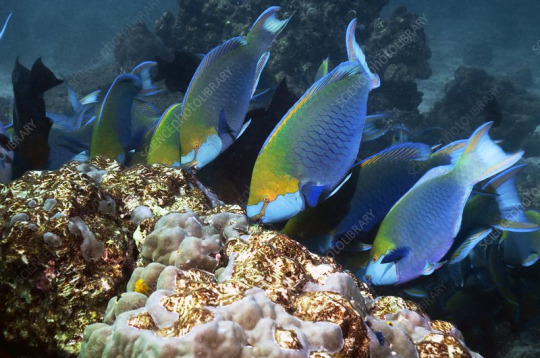
(Image: a group of many parrotfish feeding on coral. They are all the same species and are mostly blue, with yellow heads and stripes on the face. They appear to be biting the the coral. End ID)
Parrotfish are protogynous sequential hermaprodites. This means that all parrotfish are born female and can become male later in life. The transition is usually triggered when there are too many females or not enough males in a location, though in some species any fish that reaches a certain size will become male. Some parrotfish are solitary while others are social. In social species, the social groups consist of a large male and a harem of females that he protects and claims mating rights with. Other males will attempt to fight the male for dominance via headbutting and threat displays and occasionally one of his harem members will become male to challenge him. Males are usually more colorful than females, which they use to woo females, but also puts them at greater risk of predation. If the harem leader dies and is not replaces, one member of the harem will transition to male and replace him. Many species perform courtship dances during nights of the full moon. In non-social species, males will perform displays and fight with each other to attract females. In social species, the dominant male will mate with his harem while smaller males without harems will try to sneakily woo claimed females or sneak in and mate without being noticed. Parrotfish are broadcast spawners. The female releases her eggs into the water and the males releases sperm to fertilize them. The eggs will drift on the current until settling, after which the larvae will hatch. As with most fish species, only a very few of the larvae will reach adulthood.
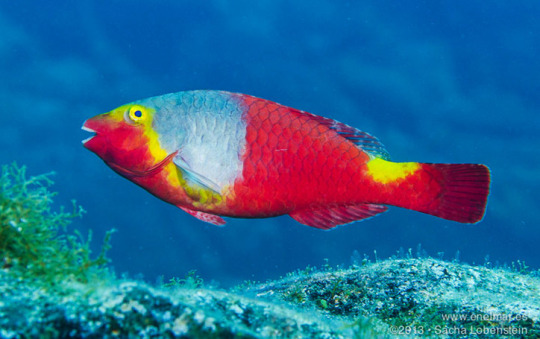
(Image: a Mediterranean parrotfish (Sparisoma cretense). It is mostly bright red, but with a yellow patch above the tail and a yellow stripe around the eye that runs down to the belly. A large patch behind the eye is blue. End ID)
Thankfully, most parrotfish species are not particularly endangered. The largest threat to them comes from habitat loss as pollution and climate change harms coral reefs. Reintroducing parrotfish to damaged reefs helps them recover. All species are edible, though there is no commercial fishery for them. While parrotfish are capable of delivering powerful bites, there are few reports of humans getting bit. That being said, I found one case where someone had skin on his penis bitten off by a parrotfish. And yes, that link has pictures. Enjoy.
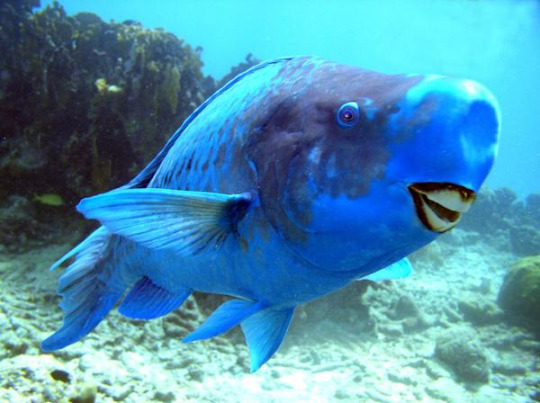
(Image: a blue parrotfish (Scarus coeruleus) looking at the camera. It is a blue fish with darker patches around the eye. Its snout is bulbous and the beak points downward. End ID).
#wet beast wednesday#parrotfish#the smiling grinner#fish#fishblr#fishposting#marine biology#biology#zoology#ecology#animal facts#coral reef#penile trauma#that's a wild tag to have on a post about fish#informative#image described
380 notes
·
View notes
Text

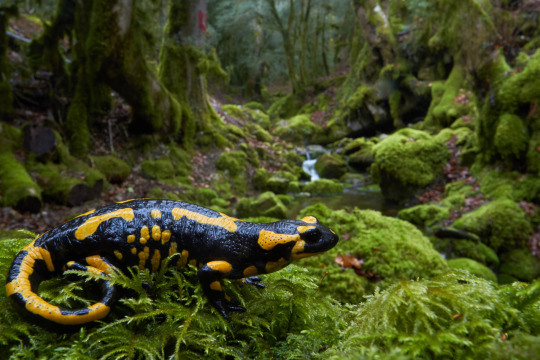
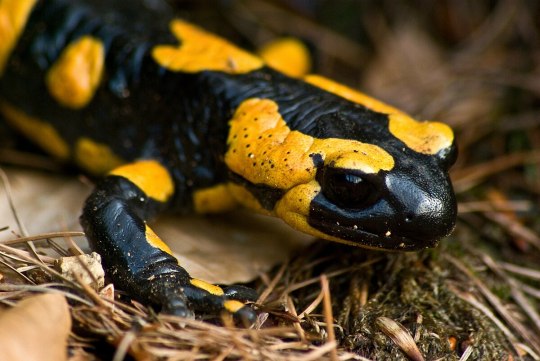
Frolic with the Fire Salamander
The fire salamander (Salamandra salamandra) is a species of salamander native to the deciduous forests of central and southern Europe. They commonly reside near sources of water such as ponds or streams, but can also be found under logs and leaf litter in moist environments.
Fire salamanders are so named for their bright yellow and black coloration, which serves to warn away potential predators. In addition to their unique look, S. salamandra is also noted as the largest salamander species, at up to 25 cm (9.8 in); females are slightly larger than males. The two are otherwise indistinguishable outside the breeding season, when the area around the male's vent swells.
Depending on their region, S. salamandra breed at different times of the year; those in colder climates begin in June or July, while populations in warmer areas mate in October. Males seek out females on land, and after a brief courtship ritual he deposits a packet of sperm for her to pick up. The eggs develop internally throughout the winter, and the female gives birth to 20-75 newly hatched larvae in the following spring. These larvae live in ponds or slow-moving streams for 3-5 months before fully metamorphosing into adults. Individuals can survive for up to 14 years in the wild.
The bright coloration of fire salamanders is a form of aposematism; warning predators of their toxicity. The skin secretes a highly potent toxin, which can also be sprayed directly at potential threats. However, only adults have this ability, so juveniles may be victim to birds, frogs, fish, and mammals like weasels and foxes. S. salamandra in turn consumes mainly insects and invertebrates like earthworms, slugs, larvae, beetles, and centipedes. They do most of their foraging at night, and rarely stray far from their small home territory./
Conservation status: The fire salamander is considered Vulnerable by the IUCN. Their main threat is from the chytrid fungus, which can wipe out entire localities. Populations are also threatened by habitat loss, as they require both pristine waters and dense forests to thrive.
Photos
William Warby
Quentin Martinez
Christian Jansky
#fire salamander#Urodela#Salamandridae#true salamanders#salamanders#amphibians#deciduous forests#deciduous forest amphibians#europe#central europe#southern europe#animal facts#biology#zoology#ecology
67 notes
·
View notes
Text
Sunseeker Ocean 182 and Predator 75
British yacht maker Sunseeker Yachts will debut two of its newest yachts at Boot Dusseldorf, the Ocean 182 and the Predator 75. Sunseeker will also showcase a strong line-up that includes the 95 Yacht, 88 Yacht, 76 Yacht, Manhattan 68, Predator 65, Manhattan 55 and Superhawk 55. Continue reading Untitled

View On WordPress
#Boat News#boat show#boot Dusseldorf 2024#new boat launches 2024#power yacht#Sports yacht#sunseeker#sunseeker ocean 182#sunseeker predator 75#sunseeker yachts
1 note
·
View note
Text
One of the best ways to hide in the deep sea: Ultra-black skin
youtube
Deep-sea animals have a variety of remarkable adaptations to help them hide in the midnight zone. But the fascinating fishes featured in this video have the best strategy to hide from predators and prey in this dark expanse: skin shades among the blackest of blacks known.
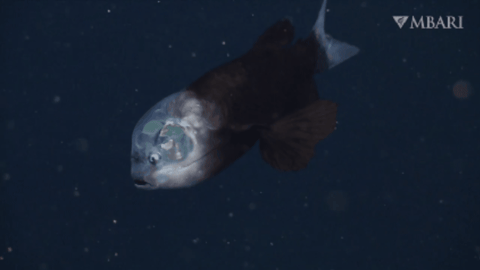
While there is no sunlight deep in the ocean, more than 75 percent of deep-sea life can produce light, a process called bioluminescence. When a single photon can blow your cover, ultra-black camouflage keeps these fishes hidden in the wide open darkness and also enables them to sneak up on unsuspecting shrimp or fish for a tasty meal.

Ultra-black fishes have unique structures in their skin that very efficiently trap and absorb light. Melanin—the same pigment found in human skin—is densely packed into super thin layers on the outermost surface of their skin. While most light photons are immediately absorbed, the specific shape, size, and configuration of these melanin layers scatters any missed photons into neighboring skin cells, where they are absorbed. Ultra-black skin absorbs 99.5 percent (or more) of the visible light with virtually none reflected.
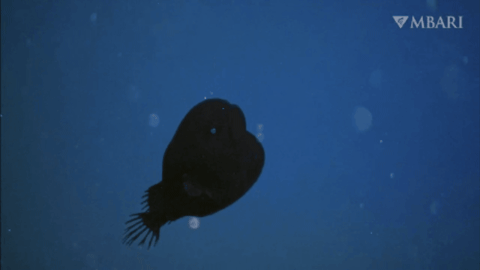
The very blackest fishes known in the deep sea are the dreamer anglerfishes (Oneirodes sp.). Anglerfishes have a bioluminescent lure they use to attract a snack. Their ultra-black skin absorbs the bioluminescent glow so as not to reveal the giant mouth just beyond the lure. This incredible skin adaptation has evolved in many other fish species as well.
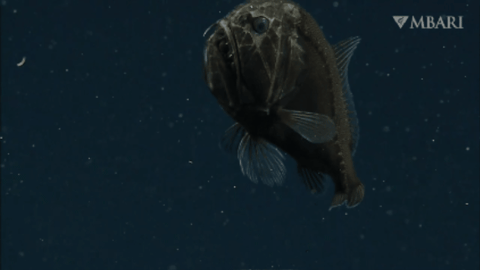
You can learn more about these amazing animals of the deep on our website.
349 notes
·
View notes
Text
Animal of the Day!
Cuban Crocodile (Crocodylus rhombifer)
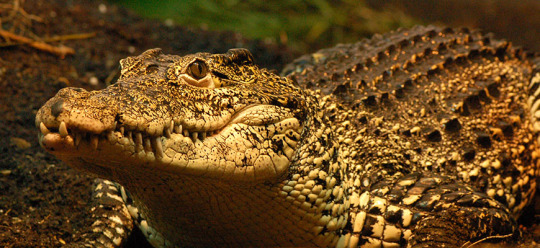
(Photo from Louisville Zoo)
Conservation Status- Critically Endangered
Habitat- Western Cuba
Size (Weight/Length)- 75 kg; 2.2 m
Diet- Small mammals; Fish; Turtles
Cool Facts- Do yourself a favor and watch a video of a Cuban crocodile galloping. These highly territorial reptiles have small dog energy and are willing to chase off the much larger American alligator that they share their home with. Cuban crocodiles may be the only crocodile to hunt in coordinated packs to take down much larger prey, showing off extraordinary levels of intelligence. Sadly, Cuban crocodiles are almost extinct in the wild due to mass hunting for their skin and meat, along with general fear for territorial predators. Luckily, zoos across the world are captive breeding Cuban crocodiles with hope for reintroduction to the wild.
Rating- 13/10 (Can run 35 kilometers per hour.)
#animal of the day#animals#reptiles#crocodiles#tuesday#january 9#cuban crocodile#biology#science#conservation#the more you know
189 notes
·
View notes
Text
normal thoughts/hcs about the entities
Both the nutcrackers and the mannequins have non-organic exteriors, but the limbs of a jester are in fact real human limbs, torn off and repurposed in the earliest parts of their life span.
Jesters start out as inert ambush predators when adolescent, but eventually gain the means to move themselves around (by biting legs off and attaching them).
Circuit bee honey is full of caffeine! They have also been known to cluster around abandoned apparatuses, flashlights, and walkie-talkies, presumably sapping them for their energy.
Masked become distressed if they're alone, and they seek out employees to convert into companions. Generally, masked are happiest when they come in a set of 4.
If you leave a boombox around a jester for a long time, the jester's wind-up tune will begin to mimic whatever song is playing.
Masked have a tendency to meander around and collect items, placing piles of them in random spots. For this reasons, masked and lootbugs are often antagonistic towards each other.
Brackens are somewhat ambush predators, as their victim's awareness of them causes hesitation. However, this hesitation is quickly replaced by hostility from looking at them too long. Several researchers believe that extended eye-contact is how Brackens signal a challenging of authority.
It's been reported by a few unlucky employees that when there are multiple nutcrackers, they will march in sync to each other.
Brackens apparently have a really hard time differentiating between a masked and an employee, judging from the fact that around 75% of observed masked have neck injuries.
134 notes
·
View notes
Text
Extermination 8.4
Armsmaster: I'm a genius! Armsmaster: Oh no!

Everything they do against Leviathan is insufficient. It's fucking horrifying.

Skitter just like "ehh, I don't think Parian's hardcore enough tbh"
Also, God, it's just getting increasingly dire just in terms of who's standing, huh? They're down most of the forcefield users at this point, the Triumvirate is down or handling other shit.
Also also I'm so sad that Purity didn't drown in the middle of the street like she deserves

Taylor is so fucking funny, she's like "I'm not brave like these other capes, I'm just standing and working to combat an Endbringer even though my power does absolutely nothing offensively or defensively against it. oh I'm not an adrenaline fiend or anything, I don't live for the thrill of battle, I just have an unreasonably high pain tolerance and not a whole lot of care for whether I live or die"

So her power gets stronger in especially high-stakes situations. Something about her emotional state, or something about an innate response to extreme threats?

Taylor's life seems to involve constant rapid-fire vacillation between predator and prey. It can't be helping with her stress levels, regardless of how good she is at being both of those things.

So this is a tactic that will slow Leviathan down, but if he gets to keep moving for too long then it will immediately turn around and bite them on the ass. Dunno how good of an idea that is tbh.

Fucking automaton freak of a superhero, truly
Also does the wider world never find it alarming that the order goes "parahumans < Endbringers < Scion" because I feel like that would prompt questions about Goldilocks on the regular

New Wave is at 75% strength and the invincible Ward just got fucking vincibled. God that's rough.

Wooo! Nazi down! Yeahhh!
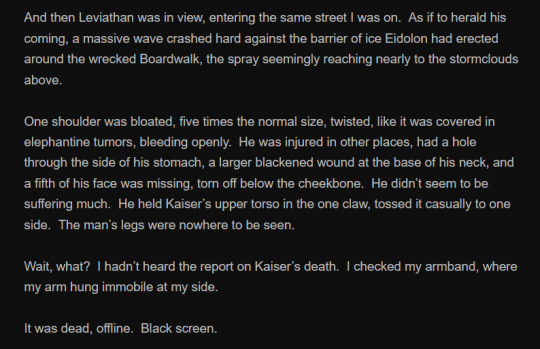
WOOOOOOO NAZI DOWN!

Hope the water slide chaps your legless ass on the way to Hell, Kaiser, you rancid fuck!
Also haha whoops I sure hope that dead armband isn't indicative of some kinda foul play

Well yeah, fuck, I guess it's a good thing she had those decoys after all

Credit where credit is due, if it was possible to actually kill an Endbringer, which I fucking doubt, this would probably be the best show of doing it.

According to Wikipedia, "hubris" describes a personality quality of extreme or excessive pride or dangerous overconfidence and complacency, often in combination with (or synonymous with) arrogance.

According to studies, hubris, arrogance, and pretension are related to the need for victory (even if it does not always mean winning) instead of reconciliation, which "friendly" groups might promote. Hubris is usually perceived as a characteristic of an individual rather than a group, although the group the offender belongs to may suffer collateral consequences from wrongful acts. Hubris often indicates a loss of contact with reality and an overestimation of one's own competence, accomplishments, or capabilities. The adjectival form of the noun hubris/hybris is hubristic/hybristic.
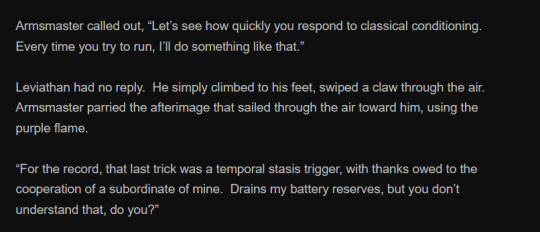
The term hubris originated in Ancient Greek, where it had several different meanings depending on the context. In legal usage, it meant assault or sexual crimes and theft of public property, and in religious usage it meant emulation of divinity or transgression against a god.
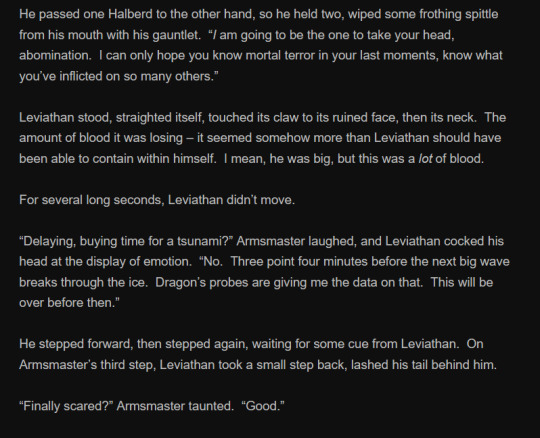
Hesiod and Aeschylus used the word "hubris" to describe transgressions against the gods. A common way that hubris was committed was when a mortal claimed to be better than a god in a particular skill or attribute. Claims like these were rarely left unpunished, and so Arachne, a talented young weaver, was transformed into a spider when she said that her skills exceeded those of the goddess Athena, even though her claim was true. Additional examples include Icarus, Phaethon, Salmoneus, Niobe, Cassiopeia, Tantalus, and Tereus.

These events were not limited to myth, and certain figures in history were considered to have been punished for committing hubris through their arrogance. One such person was king Xerxes as portrayed in Aeschylus's play The Persians, and who allegedly threw chains to bind the Hellespont sea as punishment for daring to destroy his fleet.
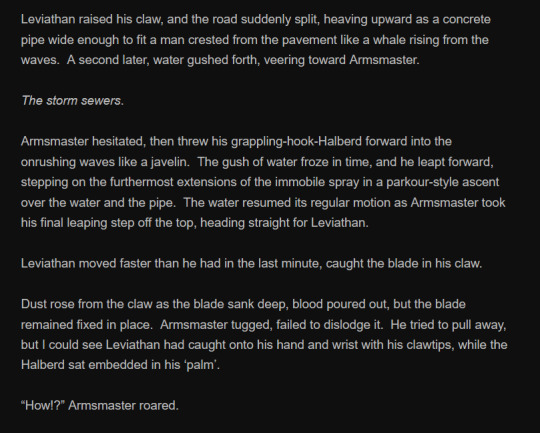
What is common in all of these examples is the breaching of limits, as the Greeks believed that the Fates (Μοῖραι) had assigned each being with a particular area of freedom, an area that even the gods could not breach

In its modern usage, hubris denotes overconfident pride combined with arrogance. Hubris is also referred to as "pride that blinds" because it often causes a committer of hubris to act in foolish ways that belie common sense.
Anyway I guess Armsmaster has to be called Armmaster now, s- oh, what's this?
Congratulations allwormdiet! You are the 4,000,000th Worm reader to make the "Armmaster joke!"
Oh boy what do I win
Nothing!
O-oh.

Tfw the teenager you deliberately attempted to sacrifice in order to get your moment of glory soloing the raid boss still tries to save your stupid ass

Fucking remarkable that Skitter is still contributing at all considering how hard she's been rocked through all of this
And she's gonna keep doing it, too.

Tfw the teenager you deliberately attempted to sacrifice in order to get your moment of glory soloing the raid boss is the only thing saving your life
Current Thoughts
Colin, Colin, Colin. We'll get into it more once the fight's over but you truly fumbled on this already rancid day. I hope like Hell this will finally get you to be a little humble.
So, some more bad losses in this chapter obviously, sad to see Aegis go for all he was kinda bland and I'm sure New Wave is going to feel their losses something fierce.
But hey, two more dead Nazi capes, so it's not all downsides!
42 notes
·
View notes
Text

What a croc! This Fossil Friday, let’s take a bite out of the weekend with Deinosuchus—a giant crocodilian that lived alongside the dinosaurs some 75 million years ago. Reaching lengths of more than 35 ft (10.7 m) and weighing more than 8,000 lbs (3628.7 kg), Deinosuchus was as long as a school bus and as heavy as an elephant, making it one of the most powerful predators in its ecosystem. In fact, partially healed bite marks found on the bones of a tyrannosaur in North America match this giant croc’s teeth, suggesting Deinosuchus could go toe to toe with even the most formidable of dinosaurs.
This image is a historical reconstruction from 1942 and is not representative of current size estimates.
Photo: Image no. 318651/ © AMNH Library
#science#amnh#museum#fossil#nature#natural history#animals#paleontology#did you know#fact of the day#fossil friday#crocodile#deinosuchus#ancient animals#predators
678 notes
·
View notes
Text
Am I missing something or is Square screwing around with the maths? Because the first soldier cinematic says jenova project was '77-'84 and if Angeal is sixteen in '92, he was born in '76. Is '77-'84 just about SOLDIER? Do the kids predate SOLDIER entirely? Because if that's true, my entire timeline is off by a few years and Jenova must have been dug up no later than '75 ('76 at a big push).

33 notes
·
View notes
Note
what is the wardi zodiac system like? what's the worst and best signs, and how seriously do people take the stars youre born under?
Ok here's a full overview because I had this like 75% typed up already
The Wardi zodiac is a very direct interpretation of each constellation the sun passes through in its ecliptic over the course of the year. There is no attempt to divide these signs evenly throughout the year (as in the western zodiac), rather every single constellation the sun passes has its own zodiac sign (ie the sun only passes the tail of the Lion for about a week of the year, while the sun takes about a month to pass through the entirety of the Gull, making the former a significantly less common sign than the latter).
As such, there are 20 astrological signs in the base system (all of which are animals). Seven of the base signs correlate directly with the seven Faces of God (the zodiac system actually predated this religion, and some preexisting signs may have been retroactively modified to fit). All of these seven signs are considered auspicious and highly positive (though still ascribed some negative personality traits), and are seen as uniquely blessed by their respective Face.
One’s zodiac sign is assumed to be highly informative of their nature and personality. One’s birthsign is described as ‘(constellation)-born’, and the personality associated gains an epithet of ‘(constellation)-faced’. IE: Someone born under the sign of the ox is Ganops (ox-born), to have the personality associated is to be Ganmachen (ox-faced).
The faces associated with the birthsigns may be used as complimentary epithets in speech and verse when the sign is considered auspicious (ie “Lion-faced Faiza”/“Faiza odomachen”), or used disparagingly, especially “dog-faced” (chinmachen), a fairly common insult that describes someone as vicious and lowly.
A birthsign is taken very seriously within the Imperial Wardi cultural sphere, but does not necessarily have fundamental impact upon the average person's daily life. There can be social benefits and detriments associated- many people will want to avoid association with certain birthsigns, or will use them as a basis to judge character. Those in leadership positions may particularly benefit from having an auspicious sign or hiding an inauspicious one. If you exist in the public eye, your sign is extremely likely to come under scrutiny and invite judgments of character, or to add ammunition to other judgments (ie it is frequently noted when unpopular historical kings were dog-born).
They're also usually taken into account for marriage arrangements, as there are established senses of compatibility among the birthsigns. This is most prominent at levels of wealth where one can afford to be choosy about arrangements, but not so high that the arrangement itself is political in nature (thus superseding concerns about compatibility).
The most significance of one's birthsign in day to day life is in the context of astrology and of traditional medicine (a holistic practice that takes a variety of physical and spiritual factors into account). The position of the stars and other celestial bodies are considered to have very strong effects on the world and individuals, as an aspect of God's spirit and Its perpetual flow through the world (the Faces Mitlamache, Inyamache, and especially Kusomache preside most heavily over the movements of the heavens). The common person is unlikely to do a detailed consultation of the stars daily, but will often seek the services of an astrologer before making major moves or life changes, or to help identify sickness. Priests devoted to Kusomache are universally trained in astrology and often provide these services, as are most healers.
BASE ZODIAC SIGNS
Ox: An auspicious sign. Considered to be hardy in nature, patient, hard workers, slow to anger but dangerous when riled, blessed with natural physical strength. They are also regarded as exceedingly stubborn and prone to grudges. The constellation is seen as an ox kneeling at rest.
Lion: An auspicious sign. Considered to have excellent leadership qualities, a heroic and regal disposition, mental acuity, and blessed with natural talent as warriors. They may be overly proud and domineering, aggressive. The constellation is seen as a maned lion mid-stride.
Khait: An auspicious sign. Considered to have spirited personalities, a tendency towards romanticism, and blessed with natural athleticism and virility (in men) and susceptible to the influence of the sun. They are considered prone to over-competitiveness and lustfulness, chasing after whims. The constellation is seen as a leaping khait, with a bright red star as its eye.
Gull: An auspicious sign. Gull-born are considered worldly and knowledgeable, blessed with good fortune, but often somewhat foolish and slow to learn their lessons. The constellation is seen as a gull with its wings spread wide.
Serpent: An auspicious sign. Considered intelligent, quiet, philosophically inclined, good politicians and wise rulers, uniquely blessed with wisdom and uniquely susceptible to the influence of the traveling stars (planets, comets). They may also be conniving and prone to plotting, and make dangerous foes. The constellation is seen as a two-headed, coiling serpent.
Aurochs: An auspicious sign, distinct from ox-born but with some similar qualities. Considered are strong-natured, hard workers, and naturally inclined towards physical strength. They are also considered to be quick to rile and to have bad tempers. Believed to be blessed with especially good fertility and to be highly susceptible to the influence of the moons. The constellation is seen as a bull aurochs with lowered horns.
Duck: An auspicious sign. They are considered wise and thrifty, graciously mannered, excellent romantic partners and parents, blessed with fertility and beauty, but often disorganized and unreliable, naive. The constellation is seen as a duck upon the water.
Horse: Considered docile and nurturing, honest, drawn to poetry and art. They may be overly anxious and dependent on others, regarded as a feeble-natured sign. The constellation is seen as a grazing horse.
Hare: Considered to be cunning, independent, jovial and friendly, but cowardly and avoidant of consequences, lacking in proper respect. The constellation is seen as a running hare.
Dragon: A sign based off a legendary animal that flies and hunts in thunderstorms, with a beaked mouth, horns, the neck of a snake, and body of a hawk. Considered egotistical, demanding, and prone to mood swings, likely to lead a tempestuous life, but a good ally to compatible signs who can match their energy. The constellation is seen as a dragon in flight.
Dog: Usually considered an inauspicious sign. Dog-born have strength in cunning and loyalty, and are considered aggressive but cowardly, often foolish and greedy, lustful, unambitious. The constellation occurs at the foot of the Hunter constellation, identified as either a loyal hunting dog following its master or a lowly scavenger looking for scraps.
King Hyena: Somewhat inauspicious, but given many respectable qualities. They are considered to have powerful and commanding personalities and natural talent as warriors. They are characterized as tyrannical in positions of power and prone to theft, often untrustworthy, brutally pragmatic. The constellation is seen as a stalking king hyena, low to the ground.
Leviathan: Considered somewhat slow-natured and quiet, closed off in personality and difficult to know. The constellation is seen as a swimming leviathan.
Rat: A somewhat inauspicious sign. Considered to be clever and frugal, very sociable, good with business, but ascribed a ruthless low cunning and greediness. The constellation is seen as a rat standing on its hind legs.
Gazelle: Considered gentle natured, emotional, easily worried and pessimistic, avoidant of conflict. The constellation is seen as a leaping gazelle.
Polecat: Considered to have a brave yet foolhardy and carefree nature, often to their own detriment. The constellation is seen as a polecat in the act of the war dance.
Scorpion: A less auspicious counterpart to the serpent as having a potentially treacherous and duplicitous nature, but pragmatic and hardy, thoughtful and quiet. The constellation is seen as a scorpion with its tail arched.
Crow: Largely inauspicious, associated with crows as negative omens. Characterized as intelligent but with a low, cynical and opportunistic nature and a tendency to hold pointless grudges. The constellation is seen as two crows in flight.
Catfish: Considered to have a hardy, simple personality, great patience and wisdom. The constellation is seen as three catfish trapped in a dwindling pool, awaiting the rains.
Pheasant: Considered naturally beautiful, confident and self-assured, foolish and egotistical, prone to vanity. The constellation is seen as a pheasant with a trailing tail.
Main character birthsigns:
Palo: dragon
Tigran: hare
Couya: crow
Faiza: lion
Janeys: dog
Brakul: ox
Hibrides: catfish
39 notes
·
View notes
Text
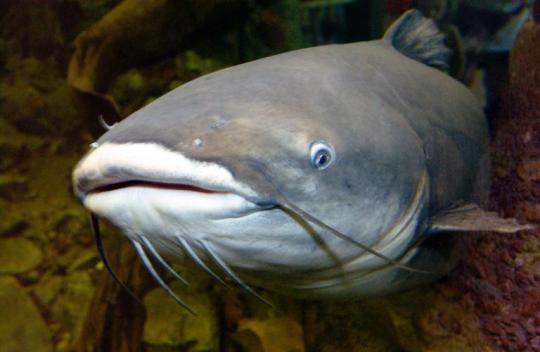
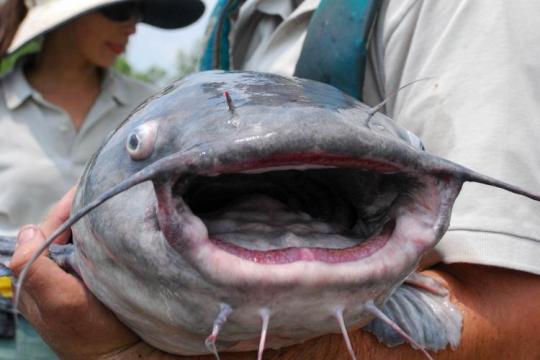
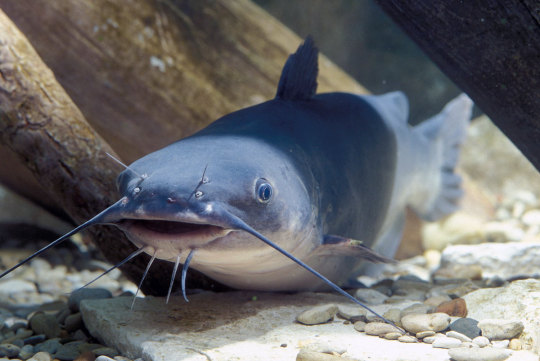
The Beautiful Blue Catfish
Blue catfish (Ictalurus furcatus) are members of the bullhead catfish family, native to the drainages of the Mississippi, Missouri, and Ohio river basins and the Gulf of Mexico. Because of their popularity as game fish, this species has also been introduced to freshwater systems throughout North and South America, and is considered invasive in these areas.
Like many catfish, I. furcatus is a bottom dweller. They can often be found near complex structures such as rocky outcroppings, fallen trees, or sunken structures that provide both food and shelter. The blue catfish is an opportunistic predator, consuming any fish or aquatic invertebrates it can find, as well as eggs, small amphibians, and injured or recently deceased animals. Adult I. furcatus are seldom prey for other species due to their size, but hatchlings and juveniles are often food for cormorants, willets, osprey, pelicans, and bald eagles. To deter predators, this species has serrated barbs along their dorsal and pectoral fins, each laced with a particularly painful toxin.
Though they can be difficult prey for other animals, the blue catfish is a popular target for fishermen, and for good reason; they're the largest species of catfish in North America. Adults can easily reach a length of 65 in (170 cm) and a weight of 165 lb (75 kg). As indicated by their name, most individuals are grey or blue, with a lighter underbelly. This species also lacks scales, a common characteristic of catfish, and the face is framed by long whisker-like barbels that help it detect nearby food.
While generally solitary, blue catfish aren't territorial, and tend to ignore each other until the mating season. Reproduction begins in April and continues until June, during which time males attract a female by building a nest and releasing attractive pheromones. Once a female has selected a male, she lays between 4,000-8,000 eggs per kilogram of bodyweight in his nest (i.e. if the female weighs 2 kg, she may lay between 8,000-16,000 eggs). The male then disperses sperm over the eggs. Following fertilization, the male chases away the female and guards the nest for about a week, at which time the eggs hatch. The hatchlings, also known as fry, stay close together in schools for several weeks before growing large enough to disperse. It will take them a further 5 years for them to reach maturity; on average individuals live about 10 years, but can live as long as 25.
Conservation status: The blue catfish is considered Least Concern by the IUCN. Within its native range, populations face minor threats from dams and droughts. Where it has been introduced, the species is considered invasive due to its voracious appetite.
If you like what I do, consider leaving a tip or buying me a ko-fi!
Photos
Missouri Department of Conservation
NOAA
Earl Nottingham
#blue catfish#Siluriformes#Ictaluridae#ictalurids#catfish#ray finned fish#bony fish#fish#freshwater fauna#freshwater fish#rivers#river fish#lakes#lake fish#north america#southern north america
230 notes
·
View notes